Statistics services for mobile applications
Hello! My name is Arseny Batyrov, I work in Yandex, and also I conduct courses on testing. In my work, I often have to choose devices for testing in various conditions. In addition to obvious parameters like dpi and OS, I often rely on the statistics of the prevalence of devices to accurately cover all the most popular combinations. This article lists services with various statistics that I use when selecting devices. If this problem is urgent for you - welcome under cat.

Without a doubt, the most popular topic in mobile testing is the approach to choosing real devices. Every tester who starts or works in the industry long ago is faced with the choice. On the one hand, the more devices - the greater the variability. On the other - time and budgets are not infinite. But a small number of devices is fraught with missed device-specific bugs and long edits. And if for iOS the choice is more or less limited, then on Android there is no number on various options. Therefore, it is necessary to choose and prioritize in any case.
When selecting devices, you can use different criteria: the size and resolution of the display, processor power, operating system version, manufacturer and so on. However, first of all, you should look at the statistics on the use of devices: first of all, those of them that your customers use are important. The importance of statistics for the selection is difficult to overestimate: the choice of devices begins with it, and the list resulting from a long dropout is checked against it.
')
Naturally, the best statistics is collected on your own application. Only it can give the most complete and accurate picture of exactly which devices your users have - and which ones should be purchased for testing. The problem is that an application that is under development does not and cannot have any statistics. There are only suggestions, which of the user groups will be your main one, and which devices they have.
In such cases, it is worth referring to external data. Many research companies are collecting lists of the most popular and selling devices, and with a certain caution in the choice you can rely on them. Beware worth three major mistakes.
First , it is important to check the relevance of statistics. Any data that is over a year old is hopelessly outdated. They can be used only as a reference, when there is simply no more relevant information. In just one year, the top 10 popular devices can change almost completely. If there is no other data, look at the names of manufacturers, and not on specific devices: most likely the companies in the list will remain approximately the same.
Secondly , consider the market in which you work. The popularity of devices varies greatly from country to country, depending on their price, operating system and many other factors. The device, which in the US in the first place in sales, may not even enter the top 10 devices in India, and vice versa. If we talk about the Russian market, then it is very popular device of Chinese manufacturers, while in Europe there are almost none. Finally, devices that are not even heard of in the rest of the world are sold and are popular in the market of Central Africa or South Asia. Therefore, taking global data on popularity and using them in the local market is a big mistake.
Thirdly , do not confuse the lists of the most popular (that is sold) and the best (powerful, expensive, well-known) devices. No one is immune from such errors. For example, once one of fellow trainers indicated that the Xiaomi Black Shark is the most popular device in Russia: a gaming smartphone with a very powerful processor and liquid cooling at the time of release. Naturally, this device was mentioned in the list of the best devices, but did not even make it into the top 100 best-selling in Russia. Carefully check that in the statistics you are looking at, it is the best-selling, not the best, devices that are mentioned.
Now let's go to specific sources. All links to the mentioned sites will be in the basement of the article.
Naturally, some statistics on operating systems can be obtained on the official websites of Google and Apple. For Android, there are detailed lists with a breakdown by version, but they are updated about once every 3 months - be sure to consider this when choosing.

Here we can see the data on devices with different sizes and density of screens.

On the Apple website , statistics are a little less detailed: here is a graph showing the prevalence of versions at the moment. Suitable for quick assessment of the share of a particular OS version on the market.

More detailed data on the distribution of the OS in the dynamics can be seen on the resource Mixpanel : one of the graphs, for example, shows the speed of adoption of iOS 12 after the release.
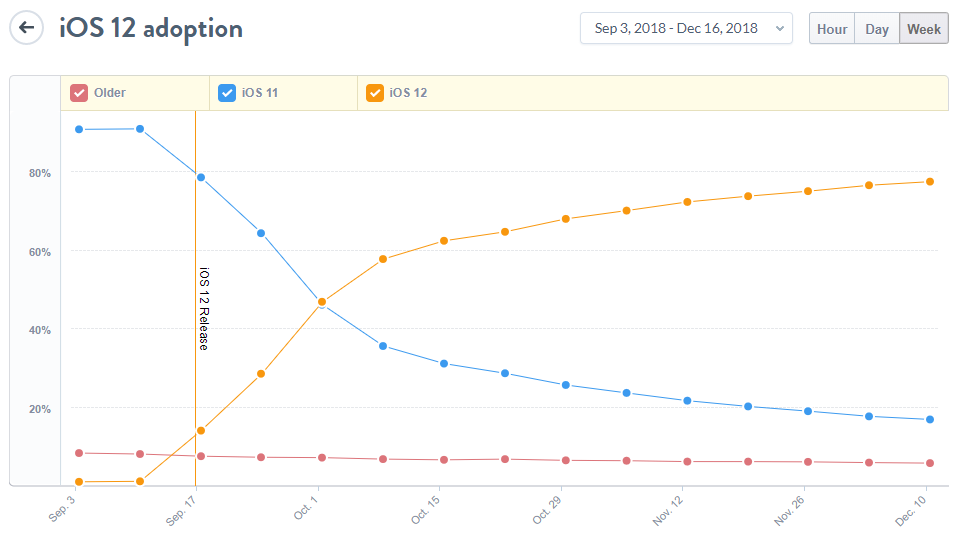
A similar graph exists for all versions of Android: here, if you wish, you can select exactly those versions that interest you.
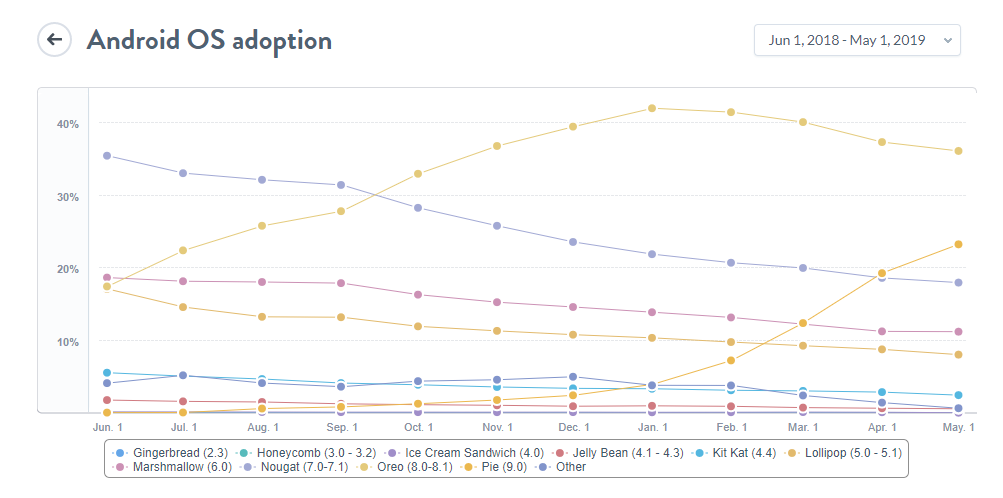
Good tops Android devices, often updated enough, provides the site appbrain.com . Here you can see which devices are common for different countries, as well as see how popular a particular device is in the world. Unfortunately, to view the popularity of the device in all countries at the same time need a paid subscription, but in testing it is rarely required. Also, if you wish, you can select a country on the world map, and click on to go to the popular android devices there. In addition, you can see a breakdown by versions of the Android OS in dynamics, which is convenient for understanding trends. For example, on this graph it is clear that Android 9 is growing faster than the share of Android 8 is decreasing, but the share of older versions remains almost unchanged.

The site browserstack.com , in addition to the ability to remotely use the device, also offers several lists of smartphones and tablets, which are suitable for testing companies with different budgets. If your application will be used around the world, or you already know that your usage statistics are close to the global statistics on the distribution of devices - you can take these lists and buy devices directly on them. Unfortunately, they are updated about once every six months or a year, so they may lag behind the real market. Also below you can see which devices should be purchased, if you are in one of these countries. Unfortunately, Russia is not among them, but if you suddenly enter the Indian or Chinese application market, use it.
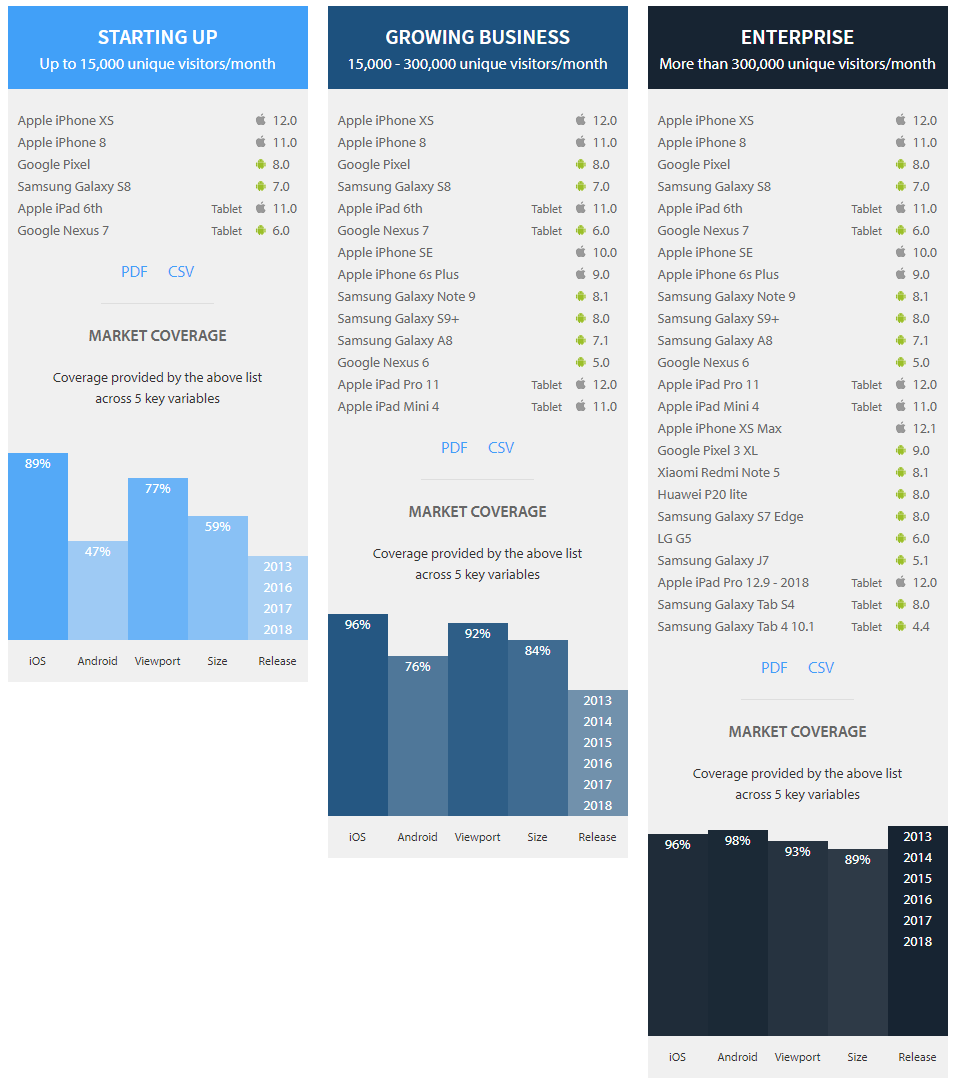
The iOS app developer's resource for audiobooks david-smith.org provides statistics on the use of various devices on this platform. The most useful graph is Device Breakdown, which allows you to quickly assess the popularity of a device on the market. In addition, you can see the distribution of older versions of the OS device, which helps when choosing such combinations for testing. Naturally, the data are given only for one application, and for individual regions they can be very different, but the site is suitable for use as a reference site - especially since the information is updated regularly.
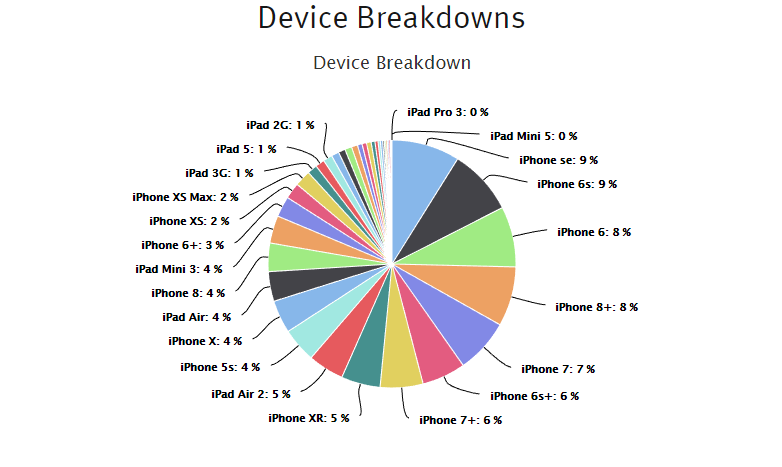
On the Device Atlas site you can see the top 12 devices for different countries. Here, unlike Appbrain, you can find both iOS and Android devices. All tops can be viewed for all countries from the list on one page, which certainly adds convenience.

Site androidnik.ru provides a selection of the most popular smartphones in 2018. Probably the same collections will be released in the future. The problem is that there are no specific numbers, and this selection seems to be subjective. But the information here is given in Russian.
But on the Kantar WorldPanel website there are no statistics for Russia, and in general there is no breakdown by specific devices. But there is a timeline, starting from January 2012, where you can dynamically see how the mobile OS market has changed in a particular country. The choice is given Android, iOS, Windows Phone and Blackberry. The last two are no longer relevant, but you can clearly see how they have lost their market shares.

There are not so many statistics on tablets, so you have to rely on data only from vendors from statista.com . Here you can see quite relevant data on the manufacturers of tablets. They are updated about once every 3 months.
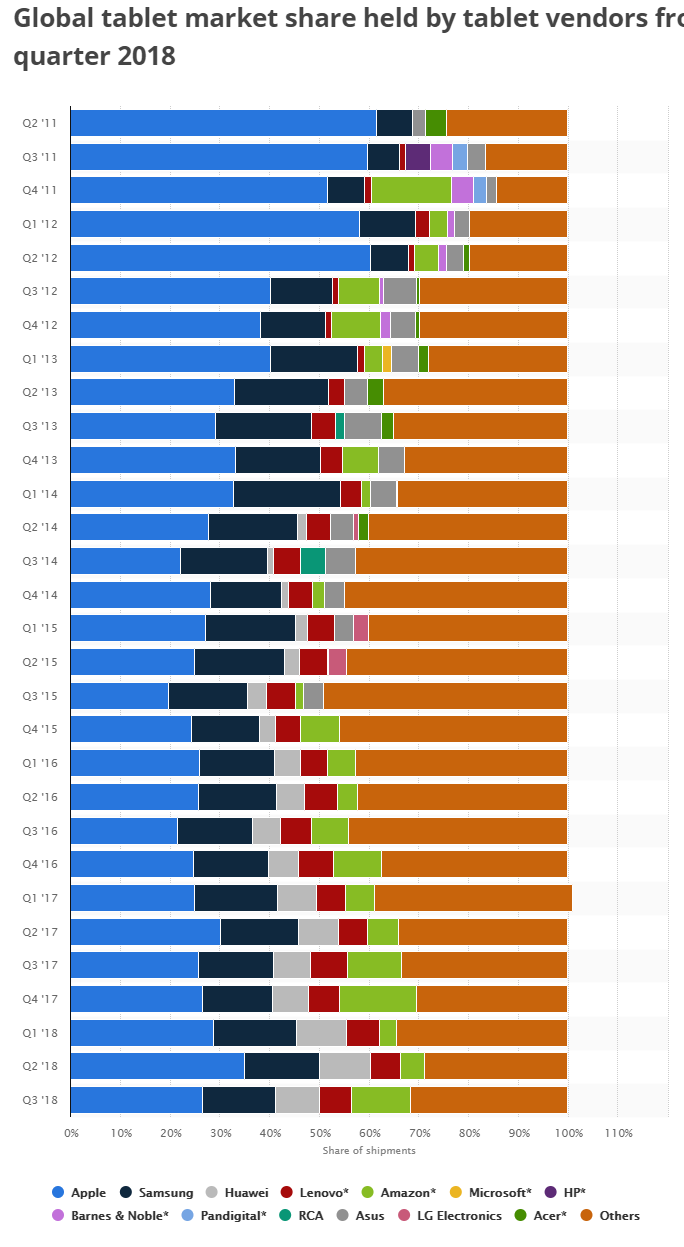
The site gs.statcounter.com has a lot of different data, including mobile. Here you can see the distribution of producers in almost all countries in the dynamics.
At the same time you can see the statistics for many years: for testing it is not so important, but it can be interesting. Here you can see the data on the types of operating systems for each country, which is useful for a quick assessment of your intended fleet of devices. Charts can be customized and, if desired, select different types of devices, countries and display methods.

Finally, the site of the mobile farm Perfecto offers a special utility that can pick up the necessary devices for testing, depending on the country, type of device and the desired operating system. Unfortunately, Russia is not among possible countries, but there are the USA, the main countries of Europe, and also some other large countries. After entering the email, you can see the full results, as well as screen shares, the number of smartphones and tablets and parts of the mobile market. If desired, you can choose the top 10 necessary devices, or devices to cover 50 and 80% of the market.

Finally, data on specific devices: their size, resolution, processor and amount of memory, OS versions and everything else - can be found on the website gsmarena.com . Enough to drive a specific device into the search - and you get a huge array of data on the device on one page.

As you can see, to select devices you have to use different data, with different relevance and reliability. Naturally, no one expects the tester to access all these resources each time in order to purchase a couple more devices. But you can always choose sites that are suitable for specific tasks, and follow the actual information on them.
If I forgot about some popular resources, or you know something about where you can get more statistics - be sure to write about it in the comments, and I will add it to the main article.
Thanks for attention!

Criteria for device selection
Without a doubt, the most popular topic in mobile testing is the approach to choosing real devices. Every tester who starts or works in the industry long ago is faced with the choice. On the one hand, the more devices - the greater the variability. On the other - time and budgets are not infinite. But a small number of devices is fraught with missed device-specific bugs and long edits. And if for iOS the choice is more or less limited, then on Android there is no number on various options. Therefore, it is necessary to choose and prioritize in any case.
When selecting devices, you can use different criteria: the size and resolution of the display, processor power, operating system version, manufacturer and so on. However, first of all, you should look at the statistics on the use of devices: first of all, those of them that your customers use are important. The importance of statistics for the selection is difficult to overestimate: the choice of devices begins with it, and the list resulting from a long dropout is checked against it.
')
Naturally, the best statistics is collected on your own application. Only it can give the most complete and accurate picture of exactly which devices your users have - and which ones should be purchased for testing. The problem is that an application that is under development does not and cannot have any statistics. There are only suggestions, which of the user groups will be your main one, and which devices they have.
In such cases, it is worth referring to external data. Many research companies are collecting lists of the most popular and selling devices, and with a certain caution in the choice you can rely on them. Beware worth three major mistakes.
Errors in data selection
First , it is important to check the relevance of statistics. Any data that is over a year old is hopelessly outdated. They can be used only as a reference, when there is simply no more relevant information. In just one year, the top 10 popular devices can change almost completely. If there is no other data, look at the names of manufacturers, and not on specific devices: most likely the companies in the list will remain approximately the same.
Secondly , consider the market in which you work. The popularity of devices varies greatly from country to country, depending on their price, operating system and many other factors. The device, which in the US in the first place in sales, may not even enter the top 10 devices in India, and vice versa. If we talk about the Russian market, then it is very popular device of Chinese manufacturers, while in Europe there are almost none. Finally, devices that are not even heard of in the rest of the world are sold and are popular in the market of Central Africa or South Asia. Therefore, taking global data on popularity and using them in the local market is a big mistake.
Thirdly , do not confuse the lists of the most popular (that is sold) and the best (powerful, expensive, well-known) devices. No one is immune from such errors. For example, once one of fellow trainers indicated that the Xiaomi Black Shark is the most popular device in Russia: a gaming smartphone with a very powerful processor and liquid cooling at the time of release. Naturally, this device was mentioned in the list of the best devices, but did not even make it into the top 100 best-selling in Russia. Carefully check that in the statistics you are looking at, it is the best-selling, not the best, devices that are mentioned.
Now let's go to specific sources. All links to the mentioned sites will be in the basement of the article.
Official data
Naturally, some statistics on operating systems can be obtained on the official websites of Google and Apple. For Android, there are detailed lists with a breakdown by version, but they are updated about once every 3 months - be sure to consider this when choosing.

Here we can see the data on devices with different sizes and density of screens.

On the Apple website , statistics are a little less detailed: here is a graph showing the prevalence of versions at the moment. Suitable for quick assessment of the share of a particular OS version on the market.

Third-party sources
Mixpanel
More detailed data on the distribution of the OS in the dynamics can be seen on the resource Mixpanel : one of the graphs, for example, shows the speed of adoption of iOS 12 after the release.

A similar graph exists for all versions of Android: here, if you wish, you can select exactly those versions that interest you.

Appbrain
Good tops Android devices, often updated enough, provides the site appbrain.com . Here you can see which devices are common for different countries, as well as see how popular a particular device is in the world. Unfortunately, to view the popularity of the device in all countries at the same time need a paid subscription, but in testing it is rarely required. Also, if you wish, you can select a country on the world map, and click on to go to the popular android devices there. In addition, you can see a breakdown by versions of the Android OS in dynamics, which is convenient for understanding trends. For example, on this graph it is clear that Android 9 is growing faster than the share of Android 8 is decreasing, but the share of older versions remains almost unchanged.

Browserstack
The site browserstack.com , in addition to the ability to remotely use the device, also offers several lists of smartphones and tablets, which are suitable for testing companies with different budgets. If your application will be used around the world, or you already know that your usage statistics are close to the global statistics on the distribution of devices - you can take these lists and buy devices directly on them. Unfortunately, they are updated about once every six months or a year, so they may lag behind the real market. Also below you can see which devices should be purchased, if you are in one of these countries. Unfortunately, Russia is not among them, but if you suddenly enter the Indian or Chinese application market, use it.

David-Smith
The iOS app developer's resource for audiobooks david-smith.org provides statistics on the use of various devices on this platform. The most useful graph is Device Breakdown, which allows you to quickly assess the popularity of a device on the market. In addition, you can see the distribution of older versions of the OS device, which helps when choosing such combinations for testing. Naturally, the data are given only for one application, and for individual regions they can be very different, but the site is suitable for use as a reference site - especially since the information is updated regularly.

Device atlas
On the Device Atlas site you can see the top 12 devices for different countries. Here, unlike Appbrain, you can find both iOS and Android devices. All tops can be viewed for all countries from the list on one page, which certainly adds convenience.

androidnik.ru
Site androidnik.ru provides a selection of the most popular smartphones in 2018. Probably the same collections will be released in the future. The problem is that there are no specific numbers, and this selection seems to be subjective. But the information here is given in Russian.
Kantar WorldPanel
But on the Kantar WorldPanel website there are no statistics for Russia, and in general there is no breakdown by specific devices. But there is a timeline, starting from January 2012, where you can dynamically see how the mobile OS market has changed in a particular country. The choice is given Android, iOS, Windows Phone and Blackberry. The last two are no longer relevant, but you can clearly see how they have lost their market shares.

statista.com
There are not so many statistics on tablets, so you have to rely on data only from vendors from statista.com . Here you can see quite relevant data on the manufacturers of tablets. They are updated about once every 3 months.

Statcounter
The site gs.statcounter.com has a lot of different data, including mobile. Here you can see the distribution of producers in almost all countries in the dynamics.
At the same time you can see the statistics for many years: for testing it is not so important, but it can be interesting. Here you can see the data on the types of operating systems for each country, which is useful for a quick assessment of your intended fleet of devices. Charts can be customized and, if desired, select different types of devices, countries and display methods.

Perfecto
Finally, the site of the mobile farm Perfecto offers a special utility that can pick up the necessary devices for testing, depending on the country, type of device and the desired operating system. Unfortunately, Russia is not among possible countries, but there are the USA, the main countries of Europe, and also some other large countries. After entering the email, you can see the full results, as well as screen shares, the number of smartphones and tablets and parts of the mobile market. If desired, you can choose the top 10 necessary devices, or devices to cover 50 and 80% of the market.

Specifications
Finally, data on specific devices: their size, resolution, processor and amount of memory, OS versions and everything else - can be found on the website gsmarena.com . Enough to drive a specific device into the search - and you get a huge array of data on the device on one page.

findings
As you can see, to select devices you have to use different data, with different relevance and reliability. Naturally, no one expects the tester to access all these resources each time in order to purchase a couple more devices. But you can always choose sites that are suitable for specific tasks, and follow the actual information on them.
If I forgot about some popular resources, or you know something about where you can get more statistics - be sure to write about it in the comments, and I will add it to the main article.
Thanks for attention!
Source: https://habr.com/ru/post/457304/
All Articles